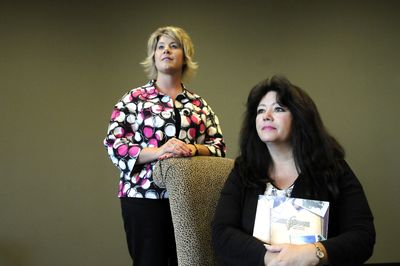Shared experience
Program helps people through grieving process

Staci Hardee and Sherry Reynolds know about grief. Six years ago Hardee’s 32-year-old husband died suddenly from an undiagnosed congenital heart condition. Two years later her father committed suicide.
Reynolds had lost both her parents, and three years ago her 19-year-old son died. Both women found comfort in a program called GriefShare.
“I was looking for something to help me through the grieving process,” Hardee said. She heard about a GriefShare group at a local church. “It ended up being the best thing I could have done.”
Though Hardee and Reynolds worked in the same building and attended the same church, friendship deepened through their losses and their experience with GriefShare. Now, they co-facilitate the group at Life Center church.
GriefShare is a 13-week video seminar/support group. According to Reynolds, the material is Bible-based, but “doesn’t preach at you.” Each week members gather and watch a DVD about topics related to grief, featuring well-known authors and counselors like Dr. Larry Crabb, Elisabeth Elliot and Dr. Bill Bright. After watching the presentation they discuss the video and share their own stories. A workbook is provided for further study and reflection.
“Society doesn’t prepare you to talk about death,” said Reynolds. ‘When you lose someone, you’re in a fog.” She said though each loss is different and people grieve uniquely, there’s great value in having a safe place to talk about the pain.
Professor Gerald Sittser, author of “A Grace Disguised: How the Soul Grows Through Loss,” met with the Hardee and Reynolds as they prepared to lead their group. Hardee said Sittser described grief in landscaping terms, likening it to a big, beautiful tree in your yard that is cut down. Your yard isn’t pretty any more, but you can re-landscape and plant new flowers and shrubs. It can be beautiful again.
“You have to go through the grief process before you can re-landscape,” Hardee said. Her own difficult journey reflecting feelings common to many. “When your spouse dies you have to figure out who you are without them. You have to make yourself go to that dark place in order to get to the other side.”
Steve Wilkins understands that dark place. He recently lost his mother to colon cancer, and five months ago his younger brother died. Wilkins describes his experience this way: “If we’re all born with a string of 100 Christmas lights, some of them went out when my mother died.” When his brother died, Wilkins said, “It was like someone had tripped over the cord, and all the lights went out. Everything went black.”
Wilkins heard about GriefShare from a client at his office and attended a group this summer. He found the videos offered practical coping skills and helped to keep his loss in perspective. “From a spiritual sense it gave me peace and comfort.” He said the class helped him re-frame his questions. “Instead of asking why did Scott die, I asked myself why did Scott live.” And while he understands his life may never go “back to normal,” he said, “Enough time can go by so you can create a new normal.”
Kim and Mark Schafer are learning how to live with that new normal after the death of their 12-year-old daughter, Madisen. Though Madisen faced significant health issues in her short life, Kim Schafer said her daughter “melted hearts everywhere she went.”
The couple was devastated by their loss but found comfort in the support they received from the GriefShare group they attended just months after their daughter’s death.
Heather Michelsen found similar help after the sudden death of her husband. “I needed to be able to function without being swallowed up by grief.” She described her loss as “an emotional slam.” While she felt fortunate to have a supportive network of family and friends, she believes GriefShare was an important part of the healing process.
That process is different for each individual. “It’s a myth that there are only seven stages of grief and you just move from one stage to the next until you are done,” said Hardee. “Grief hits you in waves when you least expect it. There is no special order you go though.”
For Hardee the most important part of the program is the hope it offers. “If you don’t have hope you don’t have anything,” she said. Her favorite part of leading these groups is to be able to offer a glimmer of light at the end of the long, dark tunnel of grief. She said she tells her group, “By the end of this class you’re going to feel hope. You’re going to have a smile on your face and be able to laugh again.”